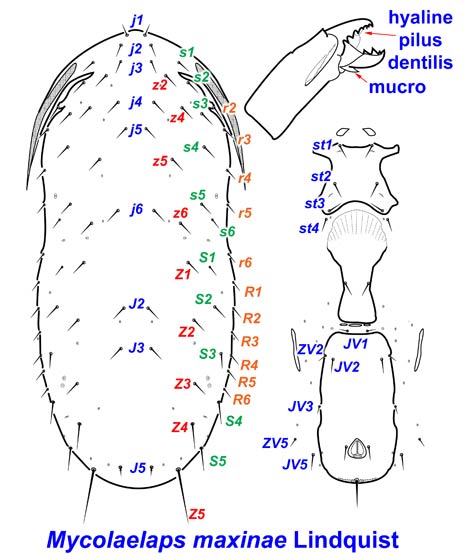Taxonomic Position
Cohort Gamasina
Subcohort Dermanyssiae
Superfamily Ascoidea
Family: Melicharidae (=Ascidae, Melicharinae)
Mycolaelaps Lindquist
Diagnostic characters:
-
Body extremely elongate to accommodate living in the spore tubes of polypore fungi.
-
Fixed chela with membranous lobe replacing pilus dentilis; movable chela with ventral mucro near base; epigynial shield truncate posteriorly, ventrianal shield bearing circum-anal setae and variable number of ventral setae; spermatheca of laelapid-type.
-
Dorsal shield entire; podonotal region with 19 pairs of setae, setae z1 & z3 absent; opisthonotal region with 19 pairs of setae, including most of the posterior marginal (R) setae, setae J1 +/- J4 absent; female without metasternal plates, st4 in soft cuticle.
-
Corniculi stout, horn-like.

-
Leg chaetotaxy variably but reduced from normal melicharine setation.
Ecology & Distribution. Mycolaelaps maxinae
Similar taxa. No other Melicharinae except species of Proctolaelaps have dorsal shields that capture most of the R-series. Species of Neojordensia and Orthadenella capture the R-setae, but have a ventrianal shield and a typical oval body shape. Highly elongate mesostigmatans are also found in the Digamasellidae (but have two dorsal shields) and in the genus Hoploseius: H. tenuis also lives in polypore fungi and is superficially similar to M. maxinae, but its dorsal shield does not capture the R-series.
Key to the genera of Melicharinae
1. Idiosoma narrow, dorsal shield greater than twice as long as wide; leg setation strongly neotenous, genua I-II-III-IV with 12-7-6-7 setae, tibiae with 11-7-6-6 setae; female lacking metasternal plates and with ventrianal shield bearing 1-3 pairs of ventral setae in addition to circumanal setae.........Mycolaelaps
- Idiosoma broader, legs not strongly neotenous, metasternal plates present or absent, only anal shield or separate anal and ventral shields............................................................................................2
2. Female with separate ventral shield bearing 4 pairs of setae between genital and anal shields; posterior connection of peritrematal shield to exopodal plate beside coxa IV broad (subequal to width of stigma); corniculi slender, acute; rows of deutosternal denticles narrow, in deep trough; epistome convex, smooth; movable chela of female unidentate...........................................................Proctogastrolaelaps
- Ventral area not sclerotized, only small anal shield with 3 circumanal setae present..........................3
3. Fixed chela of female and nymphs with pointed or rounded flange-like projection distally; leg IV with 1 or 2 erect macrosetae on telotarsus (pd2, +/- ad2); 3rd pair of sternal pores absent.......Mucroseius
- Fixed chela without distal flange-like projection; leg IV usually without macrosetae; 3rd pair of sternal pores usually present ..........................................................................................................................4
4. Dorsal shield of adults with pair of deep midlateral incisions, lacking setae z3 on podonotal region; movable chela with 0 or 1 tooth; female without metasternal plates..........................................................6
- Dorsal shield of adults entire, usually with setae z3 on podonotal region; movable chela with 3 teeth; with or without metasternal plates............................................................................................................5
5. Adults with 7-13 pairs of marginal (r-R) setae on soft lateral cuticle (rarely fewer if some r-R setae lacking); female with 14-15 pairs of setae on opisthonotal region of dorsal shield and lacking metasternal plates (except in Orolaelaps)..................................................................................................Melichares
- Adults with 1-4 pairs of posterior marginal (R) setae on soft ventro-lateral cuticle, all others on edge of dorsal shield; female with 18-22 pairs of setae on opisthonotal region of dorsal shield; female usually with metasternal plates .................................................................................................. Proctolaelaps
6. Movable chela unidentate; female with 1st pair of sternal setae on soft cuticle in front of sternal shield; male with separate ventral & anal shields; male leg II with tarsal seta pv1 unmodified.........Xanthippe
- Movable chela edentate; female with first pair of sternal setae on sternal shield; male usually with consolidated ventrianal shield; male leg II with apical tarsal seta pv-1 slightly to conspicuously thickened....7
7. Tibiae III and IV with 9 and 10 setae respectively (pl2 present); dorsal shield with setae s6; female with hyaline anterior margin of epigynial shield rounded, and with genital setae on lateral edges of this shield; male tarsus II with seta pv-1 knob- or spine-like, and tarsus III with 1-3 setae (always av2) knob-like; male spermatodactyl directed anteriorly........................................................................... Tropicoseius
- Tibiae III and IV with 8 and 9 setae respectively (pl2 absent); dorsal shield lacking setae s6; female with hyaline anterior margin of epigynial shield usually truncated or emarginated, and with genital setae on soft cuticle flanking this shield; male tarsus II with seta pv1 but slightly thickened, and tarsus III without modified setae; male spermatodactyl directed posteroventrally................................... Rhinoseius
References
Lindquist EE. 1995. Remarkable convergence between two taxa of ascid mites (Acari: Mesostigmata) adapted to living in pore tubes of bracket fungi in North America, with description of Mycolaelaps new genus. Can. J. Zool. 73: 104-128.